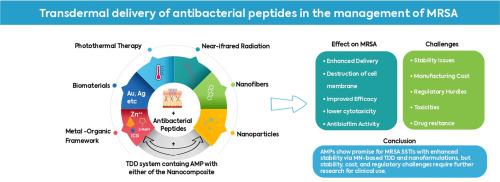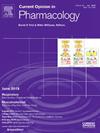Transdermal delivery of antibacterial peptides in the management of methicillin-resistant Staphylococcus aureus
IF 4.2
3区 医学
Q1 PHARMACOLOGY & PHARMACY
引用次数: 0
Abstract
Bacterial antimicrobial resistance (AMR) is of major public concern around the globe that arises when bacteria which earlier responded to the antibiotic therapy no longer respond to the same therapy and become resistant. The AMR has emerged due to the antibiotic abuse resulting in the development of multidrug-resistant (MDR) bacteria including methicillin-resistant Staphylococcus aureus (MRSA). The conventional antibiotics including vancomycin have nowadays become ineffective due to the gradual evolution and adaptation of bacteria to the surrounding environment. Antimicrobial peptides (AMPs) have emerged as an effective therapeutic option for the treatment of MRSA-induced skin and soft tissue infections (SSTIs). They offer broad-spectrum antibacterial activity with lower probability of drug resistance development. However, these AMPs face limitations such as proteolytic degradation, poor bioavailability, and potential cytotoxicity limiting their efficacy in clinical settings. Transdermal drug delivery platforms, including microneedles (MNs) coupled with the nano-formulations, have been developed to improve the AMP stability, bioavailability, and targeted release to avoid off-target cytotoxicity. Innovative strategies including Janus-type antibacterial dressings, bioresponsive MNs, and metal–organic frameworks (MOFs)-based nanocarriers have shown favorable results against the MRSA-induced skin infection. Numerous naturally occurring and synthetic antibacterial biopeptides and a Food and Drug Administration–approved glycopeptide, vancomycin, exhibited improved biofilm penetration and therapeutic efficacy when combined with smart MNs and nanosystems. Despite these improvements, challenges associated with AMP stability, cytotoxicity, and manufacturing costs still remain that limit its clinical translation. This review discussed the various MN-assisted deliveries of AMPs and associated challenges for the treatment of MRSA infections.

经皮给药抗菌肽在耐甲氧西林金黄色葡萄球菌治疗中的应用
细菌抗菌素耐药性(AMR)是全球公众关注的主要问题,当先前对抗生素治疗有反应的细菌不再对同一治疗有反应并产生耐药性时,就会出现这种情况。抗生素耐药性的出现是由于抗生素滥用导致耐甲氧西林金黄色葡萄球菌(MRSA)等多重耐药(MDR)细菌的发展。由于细菌对周围环境的逐渐进化和适应,包括万古霉素在内的传统抗生素已经失效。抗菌肽(AMPs)已成为治疗mrsa诱导的皮肤和软组织感染(SSTIs)的有效治疗选择。它们具有广谱抗菌活性,耐药可能性较低。然而,这些amp面临着诸如蛋白水解降解、生物利用度差和潜在的细胞毒性等限制其临床疗效的局限性。经皮给药平台,包括微针(MNs)与纳米制剂的结合,已经被开发出来,以提高AMP的稳定性、生物利用度和靶向释放,以避免脱靶细胞毒性。包括janus型抗菌敷料、生物反应性MNs和基于金属有机框架(mof)的纳米载体在内的创新策略在对抗mrsa诱导的皮肤感染方面显示出良好的效果。许多天然存在和合成的抗菌生物肽以及美国食品和药物管理局批准的糖肽万古霉素,在与智能纳米网络和纳米系统结合时,表现出更好的生物膜渗透和治疗效果。尽管有这些改进,但与AMP稳定性、细胞毒性和制造成本相关的挑战仍然限制了其临床转化。这篇综述讨论了各种mn辅助AMPs的交付和MRSA感染治疗的相关挑战。
本文章由计算机程序翻译,如有差异,请以英文原文为准。
求助全文
约1分钟内获得全文
求助全文
来源期刊
CiteScore
8.80
自引率
2.50%
发文量
131
审稿时长
4-8 weeks
期刊介绍:
Current Opinion in Pharmacology (COPHAR) publishes authoritative, comprehensive, and systematic reviews. COPHAR helps specialists keep up to date with a clear and readable synthesis on current advances in pharmacology and drug discovery. Expert authors annotate the most interesting papers from the expanding volume of information published today, saving valuable time and giving the reader insight on areas of importance.

 求助内容:
求助内容: 应助结果提醒方式:
应助结果提醒方式:


